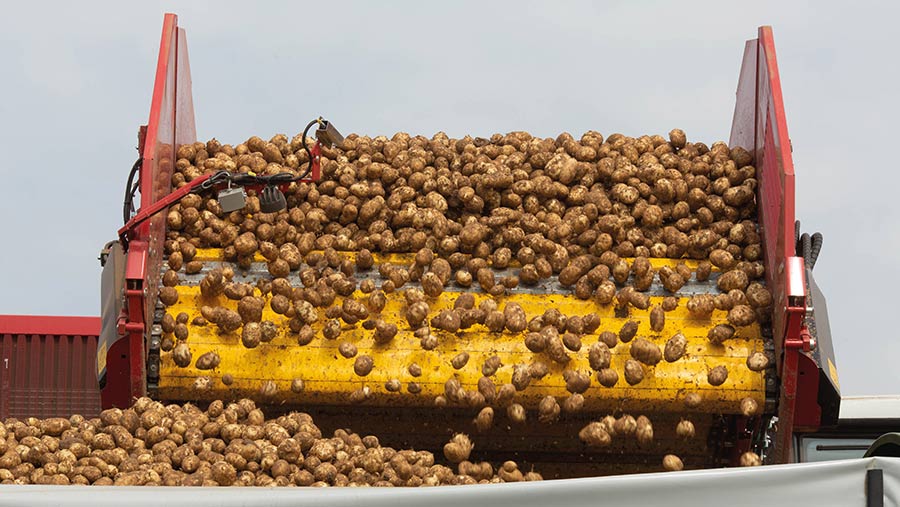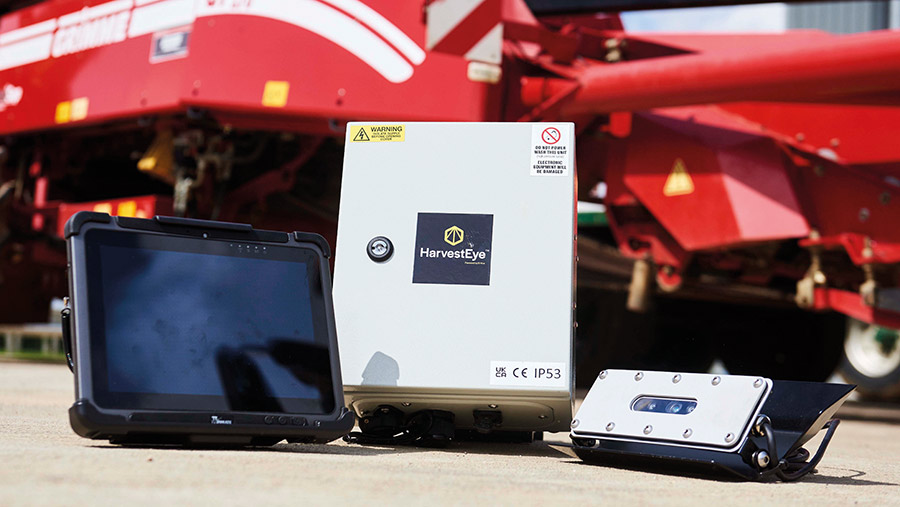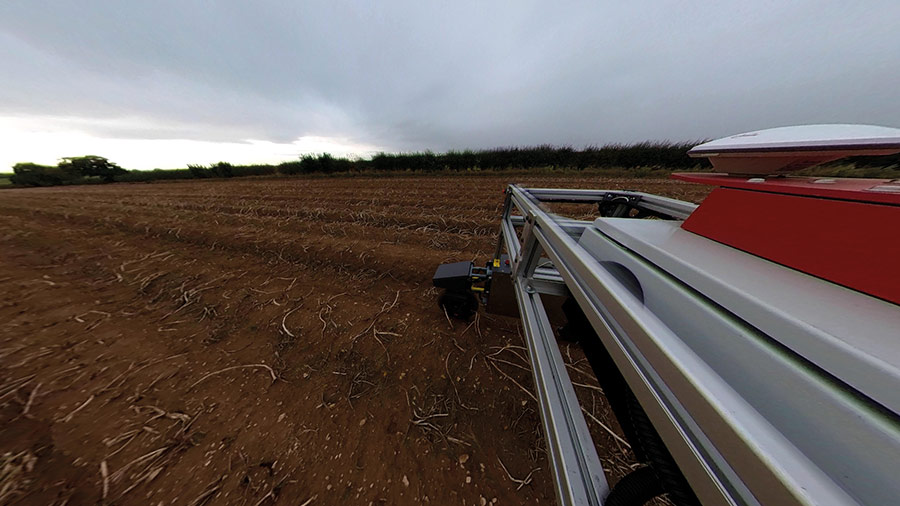How new potato tech works to improve quality and yield
 © Tim Scrivener
© Tim Scrivener A specialist agri-tech research company has developed a number of camera and sensor based technologies to improve the quality and yield of potato crops, with plans to scale up across the fresh produce sector.
B-hive innovations designed the novel HarvestEye technology which measures the size and count of crops during harvest, enabling growers to market produce more effectively.
The Lincolnshire-based company is also developing an above and below ground crop sensor called TuberScan which is capable of assessing potential yield and tuber size throughout the growing season.
Further projects include a wireworm detection programme and a four-year investigation into the detection of early diseases and defects in potato crops using novel gas sensors.
See also: Video: Cornish potato grower battles rising costs and tricky planting
Vidyanath Gururajan, the firm’s managing director says: “Our core purpose at B-hive is to reduce food and energy waste, increase marketable yield, enhance produce quality and add value to farming fresh produce businesses.
“Placing actionable insights at the hands of growers to minimise waste supports packers and retailers along the supply chain and provides assurances on the quality of potatoes,” he says.
Farmers Weekly takes a closer look at these technological developments and finds out how they have the potential to improve marketability, enhance yield and strengthen supply chains within the fresh produce sector.
HarvestEye

© B-hive Innovations
The unique HarvestEye camera system provides timely insights into the size and count of root crops as they are lifted at harvest, helping growers better market their produce.
The equipment fits to existing harvest machinery, providing real-time information on the size profile and performance of an entire potato field.
At present, potato sizing is based on small samples which often fail to account for the variability across fields according to soil type, pests and disease, which can make marketing crops a challenge.
Using integrated cameras and sophisticated computer algorithms, the technology can effectively map variety, crop performance and variability across precise field locations. This provides targeted agronomic performance data to help growers accurately reach market specifications.
Data collected by the product is then delivered to an online portal and displayed in easy-to-read bar graphs categorised by potato shape and size. These categories are user defined and sizes can be grouped as accurately as every 5mm.
Data is also displayed via GPS field maps which demonstrate where specific potato sizes are located within a field.
These insights help to better plan alignment of stocks to customers to ensure fresh produce meets quality expectations, which in turn increases food utilisation.
What’s more, data can be used to inform long-term sustainable growth by supporting complex decision making and forward planning.
The HarvestEye technology has been commercially available for use in potato and onion crops for the past two years, with future plans to expand into other crops such as carrots, beetroot and parsnips.
The system is available with a one-off hardware cost alongside an annual fee. However, other commercial models are available depending on farm size, crops harvested and grower requirements.
Key Features
- Integrated camera technology with sophisticated computer algorithms
- Can be retrofitted to existing harvester systems
- Live information during harvest as the crop is lifted from the field
- Insights in the distribution of varieties, field performance and grower group
- Starting technology for exciting future developments
TuberScan

© B-hive Innovations
TuberScan is an above and below ground crop sensor which uses radar, GPS and camera technology to survey potato crops throughout the growing season to better inform management decisions.
Now under development, the TuberScan system aims to help growers identify under-performing areas and allow targeted input applications of fertiliser, fungicides and irrigation to reduce costs and improve yield.
The project uses field-based radar technology originally developed for military use, which has been specifically adapted to the agricultural sector, using signals to monitor crop performance and provide insights into yield.
Funded by Innovate UK’s research and innovation scheme in collaboration with Branston, the University of Manchester and Harper Adams University, the project is expected to finish in February 2023.
A prototype scanner which attaches to existing farm machinery is now under development, with future plans to apply this to robotic technology which will enable autonomous scanning.
The device is expected to be commercially available to growers by 2024. It is recommended for use three to five times during the growing season, to provide data to users during key growth stages.

© B-hive Innovations
Vidyanath Gururajan, the firm’s managing director explains how the company hopes to provide growers with meaningful data-led insights to make better-informed decisions based on potato size, count and variation.
“The current practice of random sampling followed by data extrapolation to cover the field does not always account for variance within the crop and can lead to inaccuracies in forecasting.
“Why use labour-intensive sample data when cutting-edge technology will achieve more accurate data across the whole field?”, he says.
However, he admits that later on in the season when there is significant crop biomass it can be challenging to scan through crop foliage. This is why his company is working closely with Manchester University to help support this technological advancement.
B-hive hopes the project will be a catalyst towards further innovations of precision-based equipment, such as intelligent sprayers.
“As we are constantly refining and developing new technologies to increase the accessibility for intelligence-led planning to potato farmers, TuberScan aims to improve marketable yield, reduce crop variation, increase food utilisation and reduce the carbon footprint within the potato supply chain,” says Mr Gururajan.
Other new technologies in development
Early disease monitoring
Agri-tech company B-hive Innovations is also leading a four-year research programme which aims to detect early diseases and defects in potato crops before they reach supermarket shelves.
The project, known as TuberSense, will help to establish a framework for crop disease prevention and precision detection from farm to fork through the development of novel gas sensors.
Using volatile biomarkers and innovative sensors to detect different gases released by potatoes in cold stores, the project hopes to identify potatoes which have internal defects early-on.
This will in turn have a high impact on reducing crop waste and increasing food safety as crops can be sold before the infection manifests itself into its full form.
The project is part of a Future Leaders Fellowship.
Wireworm detection
A further project using camera technology to detect wireworm populations within soils aims to help farmers plan rotations and improve crop yields by identifying high-risk fields.
Field scanning is set to take place before the crop is planted using a camera attached to existing farm machinery such as cultivators or bed-formers. This will assess the abundance of wireworm populations and map the exact location within the field using GPS.

